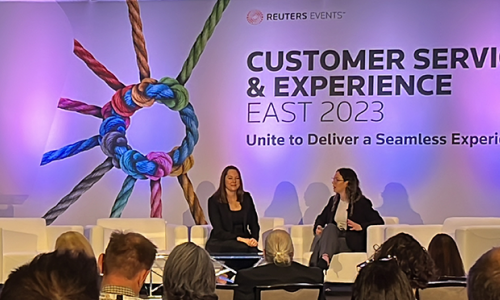I recently received a “Happy Birthday” email from Cathay Pacific Airlines, of which I am a loyalty club member. There was no sales pitch or promotion included. The company simply acknowledged my special day and wished me well.
Of course this was likely pre-programmed and automated through a marketing automation tool. But how it was implemented doesn’t matter as much as the fact that the company took the time to interact with me. I appreciate the outreach, which adds another positive notch to my perception of the airline.
A smile, a handwritten note, or just being greeted by name—these are small gestures that make you feel like a valued customer. In today’s data-driven and digital-first world, it’s easy for businesses to overlook the value of making a genuine connection with customers. But that’s precisely why more companies need to pay attention to details like customer-centric gestures.
When customers are at the heart of everything a business does, it is often reflected in the customer retention rate. Employees willing to sacrifice an immediate sale or their time for the sake of easing a customer’s concerns do not go unnoticed. And given that customer retention typically costs less than attracting new customers, companies can’t afford not to make their customers feel valuable.
Small businesses know this. The personal relationships they develop with customers keep most of them in business. But as companies scale, this imperative often gets lost. Many enterprise firms strive to return to the “corner store” relationship with individuals, but talk themselves out of it based on costs or complexity. But it’s quite simple, actually. Allow the humans representing your brand to be human with your human customers. Keep humanity a tenet of customer engagement. Here are five ways to add more humanity to customer engagement.
1. Embrace the human moment at every level
Customer centricity must start at the top. It is the CEO’s duty to formulate a strategy for understanding and meeting the customer’s needs and see to it that his or her employees are aligned with that vision. By the same token, not every interaction can be scripted, which is why a customer-focused culture is also critical.
The best company cultures allow for the flexibility and authenticity of the human moment. Training employees to greet customers pleasantly only goes so far. Employees also need the freedom to connect with customers as people in genuine ways. For example, some insurance companies give their associates the option of sending customers celebratory or sympathy cards, and some associates choose to include a handwritten message.
Encourage employees to lead with empathy in customer interactions, not just conduct transactional tasks. Employees should focus on customers and help them solve problems, not rush them through the interaction to save on handle time. Encourage employees to take the time to connect on the little things.
Marketers learned early in the digital age that social media engagement must be authentic and have people behind it to work. This notion has now spread to every customer interaction.
2. Empower employees to creatively help customers
Look beyond the obvious with your customers. An example is a claim on car insurance. The employee can instruct customers on the steps to file a police report or DMV notification, but can also take the time to help recognize the stress the customer is under and make sure they are OK. Sometimes they may just listen to customers who want to share their story or vent. As experts in the insurance field, they can also reassure customers that these things happen and they are there to help take some of the stress away. In this example, just asking the personal question about how you, the customer, is feeling can be immensely powerful because we don’t expect it.
3. Invest wisely, often with little or no expense
It’s tempting to write off efforts to improve the customer experience as extraneous or too costly. But when company leaders say they don’t have time or the budget to better serve customers, that should lead employees to question the company’s purpose.
Starbucks Chairman and Chief Executive Howard Schultz famously closed all Starbucks locations for three hours during a normal business day to provide a refresher course in the art of making espresso, as well as to discuss the importance of learning who the regular customers are and greeting them by name.
Grand gestures like these grab headlines, but it’s not necessary to make a public display of improving the customer experience. Something as simple as adding an automated “Happy Birthday” message to a bank’s ATM machine or offering a towel to a guest at the pool who forgot to pick one up can earn a customer’s loyalty.
Technology can be a powerful part of connecting the small things. Data analytics and CRM tools that prompt employees about customer history and preferences show customers that the brand knows and cares about them. This knowledge makes a customer feel special and appreciated. Imagine how it feels when you walk into your favorite restaurant and you are greeted by name. There is no reason that should not happen in every environment. Costs of these tools are dropping every day, which warrant a look for companies committed to customer centricity.
Often low-cost or no-cost approaches yield enormous customer retention and advocacy benefits, which can be translated into ROI.
4. Fail (and learn) fast
There are a number of ways to track the value of an improved experience through customer feedback programs and attrition/retention rates. What’s important, though, is not to get bogged down by the numbers. Rather than spend six months gathering intelligence to find the right touchpoints to focus on, introduce a small project and learn from the results. Start with one or two channels and add more based on customer feedback. Ask customers what their expectations of the brand are, so that you focus on the areas that serve these needs best.
Additionally, the automation trend around customer services cannot be an excuse for failing to provide a satisfying customer experience. The average company today has more than enough data from a CRM system to deliver personalized services. It is not difficult, for example, to map a caller’s phone number or email address with a customer record. In fact, some airlines will automatically alert passengers of a flight delay or cancelation and provide alternate flights. And when the passenger calls, the automated system already knows if the caller has a current reservation and can quickly offer assistance.
At the same time, many companies have yet to effectively leverage their data this way. It’s common for customers to be bounced from one department to another and repeat their question each time when databases are not connected. And longtime customers are understandably frustrated, especially when the business doesn’t take the time to acknowledge their loyalty.
5. Look for opportunities to be real
Whether it’s a handwritten card or a waived fee, the best moments are unscripted and occur simply because an employee knows it’s the right thing to do. A strong culture will create employees always looking for a chance to show a customer they care on a personal level. Engage you employees in this process. They are the ones engaging with your customers and they are your business. They will have many ideas to make things more personal for your customers and they will enjoy being part of the process and having the ability to participate in the business as contributors not just doers.
Small businesses have it right. The key is to apply the small business mindset to large corporations to build relationship strength with customers. The means are there, whether they be automation systems or something as simple as a personal greeting. The missing link is the culture designed to encourage real human connections, and the ability for employees to tap into these moments when they arise. Whether organizational leaders understand the value of this behavior and embrace it is up to them.






